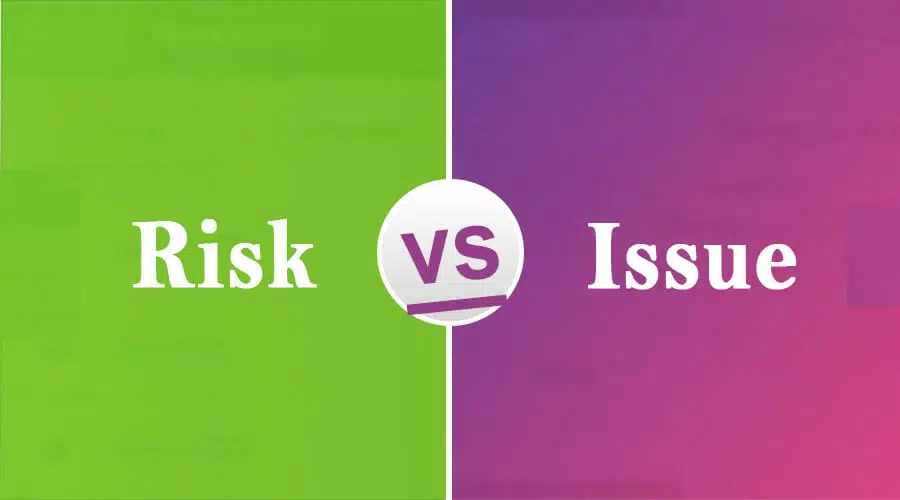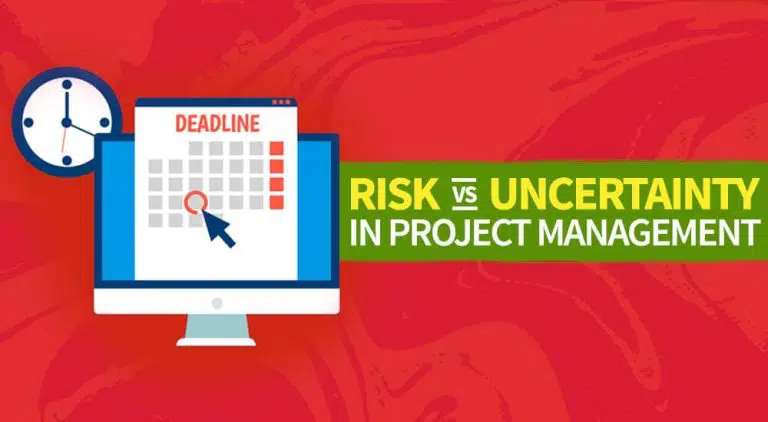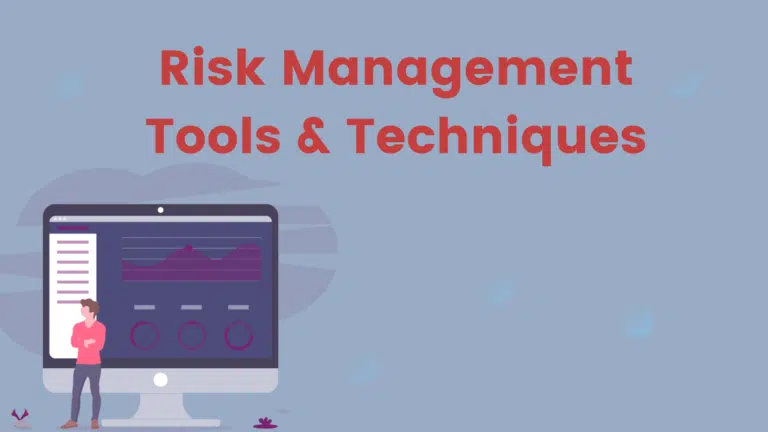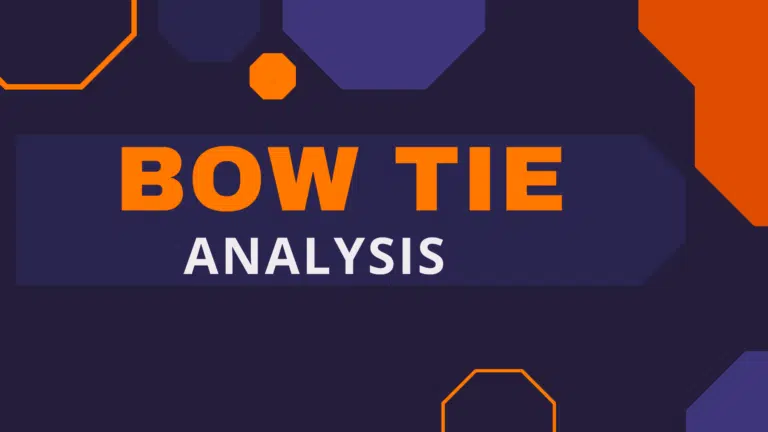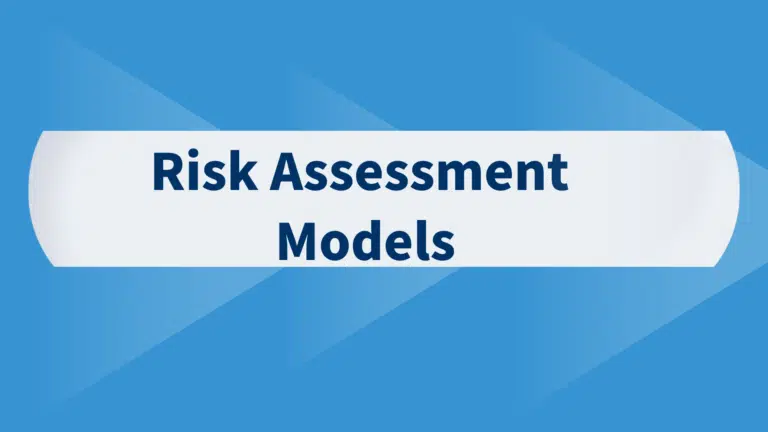Today we will discuss risk vs issue.
Risk management is an integral part of project management, and risk and issue are common risk management terms that many professionals think are the same, which is incorrect.
Therefore, I am writing this blog post to help you understand the difference between issues and risks.
I hope this post will help you understand the difference between the two and how to best deal with issues and risks.
Risk Vs Issue
We will look at risks vs issues, identify them, and how you can mitigate or resolve these problems as they arise.
Risk
A risk is an uncertain event or condition that, upon occurring, affects at least one project objective. A risk is often associated with negative outcomes, such as missed deadlines or budget overruns. Risks can be positive and bring opportunities for your project.
Risk management is not just developing a plan to minimize the probability and impact of negative risks but also maximizing the chance or impact of positive risks.
There are three key steps in risk management:
- Risk Identification: This involves identifying risks and categorizing them according to their likelihood and impact.
- Risk Response Planning: Once risks have been identified, you need to develop a plan to deal with them.
- Monitoring and Controlling: Here, you ensure that risk response plans are implemented as planned.
You have many tools and techniques for risk identification and response planning, including brainstorming, cause-and-effect diagrams, expected monetary value (EMV), and decision trees. You can tailor your approach to your project needs and use the most appropriate tools.
No matter how well you plan, the project will have risks. Understanding risk lets you minimize the chances of any negative impacts on your project.
Types of Risk in Project Management
There are various types of risk in project management:
- Technical Risks: These refer to the possibility that the technology used in the project might not work as planned. For example, a new software program used in the project for the first time may not function correctly.
- Managerial Risks: These risks include internal factors, such as poor communication between team members. This can often slow down a project or even cause it to fail altogether.
- Business/Sponsorship Risk: Business risk can change the company’s goals and priorities and jeopardize your project. This usually happens during times of company restructuring or mergers and acquisitions.
- Financial Risk: Financial risks typically refer to possible monetary loss, for example, inaccurate cost estimation, an overly optimistic budget, etc.
- Organizational Risks: These include risks like a project not receiving the necessary support from stakeholders to be completed successfully.
- Reputational Risk: This happens when the project is negatively impacted by something that reflects poorly on your company, such as a scandal or other issues related to ethics.
- Strategic Risk: Strategic risks affect an organization’s core and cause it to lose potential customers if not resolved in time. For example, a competitor could enter the market and take away your share.
- Performance Risk: This is when the project’s actual outcome differs from what was initially intended. It results from the project team not meeting the set deadlines or goals.
- Schedule Risk: This refers to the risk of a project being delayed due to insufficient testing time.
- Scope Risks: Scope risks relate directly to your product or service and can impact its quality if not managed carefully. For example, adding new features without going through the change management process could delay the product release with glitches.
- Operational Risk: This type of risk is the possibility that your team will not cope with unexpected events during a project. For example, team members cannot work during an earthquake due to damage at the worksite.
- Resource Risks: These refer to factors such as insufficient or unqualified staff members, which could cause delays in your project due to their inability to meet deadlines.
- Environmental Risks: These are risks posed by external factors, such as natural disasters or political instability in a certain region.
Issue
An issue in project management refers to any problem or current obstacle that could prevent the project from achieving its objectives. An issue has either already happened or is happening at the moment.
A project can have many issues, and you must prepare to deal with them. Some common issues in project management are:
- Communication gaps among team members.
- Conflicting goals or objectives among team members.
- Unclear roles and responsibilities among team members.
- Ineffective problem-solving among team members.
- Lack of coordination between different departments or teams.
- Inability to meet deadlines or milestones.
- Poor planning and execution.
You have to deal with these issues when they arise. This may include backup plans, fallback options, contingency budgets, and schedules. By preparing for issues, you can reduce their chances of causing problems.
When an issue occurs, it’s important to determine the root cause and how you will deal with resolving it. You may need to adjust your schedule or change some project deliverables to correct any problems.
Differences Between Risks and Issues
The key differences between risks and issues in project management are:
You cannot eliminate risks, although you can mitigate them differently. Existing problems should be identified during planning to fix them before they become problems.
Risks are often caused by external factors, while issues are mostly internal to the project. For example, a supplier may not deliver a key component on time, while an issue could be that the team missed its deadlines.
Risks are future-focused, while issues have already occurred. This means that risks are events that may or may not happen, but they could impact the project if they do occur. Issues have already happened, and you must address them as soon as possible.
Risks can be either positive or negative, while issues negatively impact projects.
The response to risks and issues is different. Risk management seeks to eliminate the probability of negative events.
On the other hand, issue management tries to resolve or reduce impacts that have already happened by providing solutions for problems within the project. Risks are dealt with through the risk management process, while issues are managed through the issue management process.
Risks cost money, while issues can cost money and time. Risks need to be monitored and responded to, which requires resources; while issues have already impacted the project, you must fix them immediately.
Risks can be quantified and measured through probability and impact, while issues cannot.
There is a difference in the documentation needed for risks and issues. Risks must be documented in a risk register, while issues can be tracked on a defect tracker or problem log.
Not all risks will become issues. However, tracking and monitoring risks closely is important, as they may become issues.

If any issues were not identified during risk planning, you manage them through a workaround.
Documenting Risks and Issues in Project Management
Risks and issues are documented in different ways in project management. The level of detail in this documentation can vary depending on the size and complexity of the project and the organization’s risk management procedures.
Risk data can be documented in a risk log or register, which has the following information:
- Risk’s full name
- Description of the risk
- Impacts expected
- Date when you’d want to have a solution
- Mitigation techniques
A project manager can use an issue register or issue log to track issues. The following information can be found in an issue register:
- The log’s date
- The problem’s description
- Steps and actions to take
- Updates on the progress
- Assessment of the effects
- Date and details of the resolution
While documenting risks and issues, you should include all relevant information. Remember that precision is key when documenting risks and issues in project management.
Risk Example
An example of a risk is as follows:
John works for a construction company as a project manager. While compiling the business plan, he evaluates the project risk. He realizes that his team might not complete the construction on time with the current schedule. He wants to handle this risk since the client’s deadline is critical.
He develops a risk response plan for the risk. He calculates that they will finish on time if he adds another team member to the project. He informs his crew of the modification, and they complete the project on time.
Issue Example
To be an effective project manager, it is important to know the different issues that can occur during a project.
Here is an example of an issue:
Hoover Software is a multinational software firm. Christina leads a massive network as the project manager for a new design. She develops a schedule and budget but now learns that team members are missing task deadlines due to inefficient communication. She documents the problem in the company’s issue log and develops a new communication strategy.
She decides to prioritize communication in a variety of ways. To begin, she schedules a weekly meeting in the middle of each team member’s shift so everyone can participate. She also introduces a new online communication tool that members can use anytime. She makes it easier for everybody to communicate effectively and accomplish duties on schedule by posting all tasks online.
Why Issues and Risks are Recorded and Managed Separately
- Risks require a separate response. They have different responses to positive and negative risks. In contrast, issues are mostly negative and require corrective action.
- Risks and issues are separate, so they must have different mechanisms to deal with them. Issues are events that have occurred, while risks are events that can occur in the future.
- Proactive risk management ensures that the project has minimal issues.
- Issues are problems on hand, and managing them is necessary to keep them from affecting your project.
- If your project is experiencing many issues, it indicates that your risk management plan was not sound.
Assumption and Constraint Vs Risk and Issue
Since we are discussing issues and risks, you should know two more terms you might encounter along with risk and issues: assumptions and constraints.
- Assumptions are conditions that are supposed to be true. If these assumption terms turn false, they may become risks and issues.
- Constraints are limitations imposed on the project. If they turn false, they would be beneficial for the project. These constraints can sometimes change to risks or issues.
Conclusion
A project manager needs to have a plan in place for risk management. If you are not prepared for risks, they can become issues.
In conclusion, understanding these two terms lets you address them better and helps you complete the project with fewer hurdles.
Here is where this post on risk vs issue ends.
Note that this topic is important from a PMP exam point of view.
Please share your experience handling issues and risks on your project through the comments section.

I am Mohammad Fahad Usmani, B.E. PMP, PMI-RMP. I have been blogging on project management topics since 2011. To date, thousands of professionals have passed the PMP exam using my resources.

